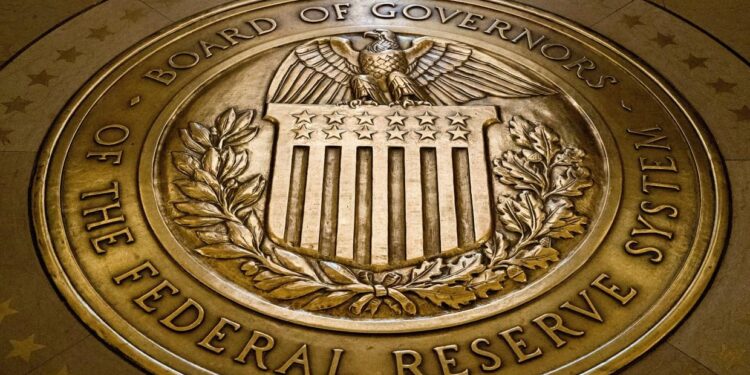Federal Reserve’s Interest Rate Decision: A Complex Balancing Act
In an unexpected move, officials from the Federal Reserve decided to keep interest rates steady, even as the U.S. economy showed signs of contraction in the first quarter. This choice highlights the intricate balancing act that the central bank must perform as it confronts ongoing inflationary challenges while also dealing with increasing economic uncertainty. Many analysts had predicted that weak growth signals would lead to a more lenient monetary policy; however, this decision reflects the Fed’s dedication to ensuring stability in a volatile economic environment. As both businesses and consumers look for guidance from policymakers, this decision carries significant implications for financial markets and overall economic health.
Fed’s Interest Rate Decision Triggers Economic Discussion
The Federal Reserve’s recent choice to maintain current interest rates has sparked intense debate among economists and market experts. With evidence of a contracting U.S. economy during Q1, many expected a more aggressive stance involving rate cuts aimed at stimulating growth. However, Fed officials cited various factors influencing their decision-making process, including persistent inflation and a resilient job market. Economists remain divided on whether this approach is wise or if it represents a missed chance to bolster recovery during such a critical period.
Critics contend that holding interest rates steady could further hinder economic expansion—particularly affecting small businesses dependent on affordable borrowing costs. Conversely, supporters argue that lowering rates might worsen inflation issues and jeopardize recent efforts aimed at price stabilization. The discussion continues as economists evaluate potential outcomes stemming from the Fed’s latest policy direction with key considerations including:
- Inflation Levels: Rising prices continue to be a primary concern.
- Employment Trends: While job creation remains strong, wage increases have stagnated.
- Global Economic Factors: International developments may influence U.S exports significantly.
Impact of Q1 Economic Contraction on Future Monetary Policy
The contraction observed in the U.S economy during Q1 has left both economists and policymakers contemplating its broader implications for future monetary strategies. The unexpected decline in GDP figures underscores the complexity faced by the Federal Reserve as it opts not to adjust interest rates amidst high inflation levels while needing to support growth initiatives simultaneously. This uncertain backdrop may lead towards tighter monetary policies as officials evaluate whether existing measures are adequate for fostering recovery.
A few critical factors likely influencing future policy decisions include:
- Tendencies in Inflation: How ongoing trends regarding pricing pressures will shape rate-setting approaches by the Fed.
- Dynamics of Labor Markets: The strength of employment figures and their effects on wages and consumer spending patterns will be crucial for overall recovery efforts.
- Status of Global Economies: How international market conditions affect domestic growth prospects will play an important role moving forward.
| Critical Factors | Potential Outcomes |
|---|---|
| Inflation Rates | Might compel further tightening by Fed authorities |
The decisions made by Federal Reserve officials over upcoming months are poised to significantly influence economic trajectories across various sectors; thus maintaining adaptability within policy responses while closely monitoring indicators related to economic vitality is essential for achieving sustained recovery without exacerbating inflation concerns further down the line.
Investor Strategies Amidst Volatile Economy and Static Rates
The recent announcement from Federal Reserve leaders regarding unchanged interest rates—despite evident contractions within Q1—has prompted investors toward more resilient investment strategies amid uncertainty surrounding traditional markets’ performance levels going forward into 2023-2024 fiscal periods ahead! To navigate these turbulent waters effectively requires diversification across portfolios through alternative asset classes like real estate investments or commodities which can serve protective roles against fluctuations seen within equity markets historically known volatility patterns observed previously over timeframes similar today!
A focus should also be placed upon maintaining liquidity positions through short-term bonds/money market accounts yielding modest returns whilst safeguarding capital reserves intact! Crafting strategic asset allocation plans balancing risk/reward ratios alongside continuous evaluations based upon prevailing market indicators/economic forecasts enables investors positioning themselves optimally when opportunities arise unexpectedly later down road ahead! Below is an overview table summarizing potential asset classes along with their performance outlooks under stagnant rate environments currently being experienced globally today!
| Asset Category | Performance Outlook |
|---|---|
| Real Estate Investments | Stable income streams & possible appreciation value gains over timeframes considered favorable long-term horizons ahead! |
| Commodities Trading Opportunities | < td >Hedging against rising inflations pressures due demand variances impacting supply chains globally !|
| Lower risks associated but yield modest returns compared other options available out there currently ! | |
| High volatility present yet potential exists generating substantial profits depending timing entry/exit points chosen wisely ! | |
|
|































